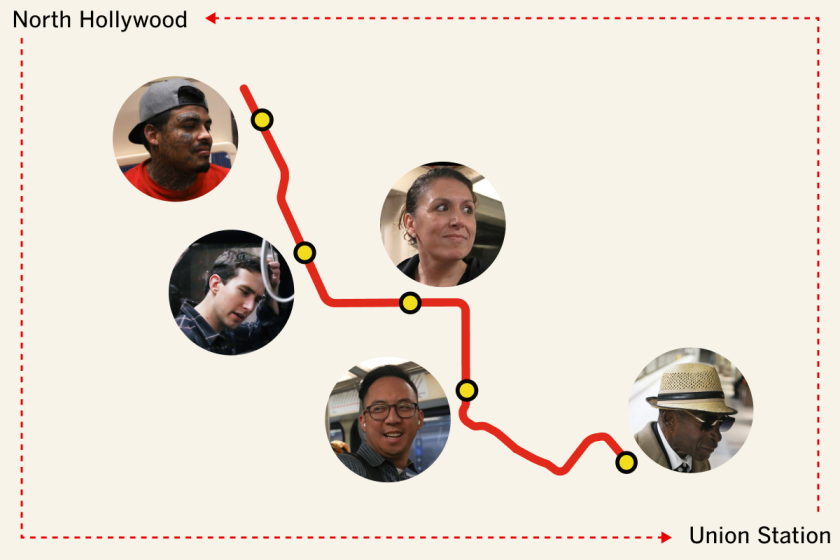‘Game-changer for the Valley’: Almost 1,500 new housing units to be built at North Hollywood Metro station

- Share via
As part of an ongoing Metro effort to build housing and community around transportation hubs, a new mixed-use development dubbed District NoHo is coming to North Hollywood’s Metro station.
The Los Angeles City Council voted Friday to approve the 15-acre project, greenlighting a massive development that will include 1,481 residential units as well as office, retail and restaurant space.
A quarter of the units will be rent-restricted, more than double the ratio required for the city’s density bonus.
“District NoHo will be a transformative project for this city,” City Council President Paul Krekorian said in a statement. Krekorian represents Council District 2, which includes North Hollywood.
“This is a truly transit-oriented development that will enable hundreds of Angelenos to live, work, study, shop and enjoy recreation without driving, parking or riding in anything other than zero-emission public transportation,” he said.
They’re your co-workers, your neighbors and some of the only people you can’t blame for making rush-hour traffic worse. We met them riding the Metro B Line start to finish, interviewing everyone we could onboard.
The project will also bring to the area 750 parking spots reserved for Metro customers, and two acres of open space for the public as well as three shopping plazas. The North Hollywood station is Metro’s third busiest.
District NoHo is one of Metro’s several joint development projects, which are real estate collaborations between Metro and private developers built on Metro land to create more housing around transit.
The project will feature improvements to North Hollywood’s Metro station, including a new entrance to the B Line subway on the west side of Lankershim Boulevard, improvements to the G Line busway terminus, and new internal streets and walkways to break up the large development site, a city report said.
Metro has made the ambitious commitment to build 10,000 housing units in Los Angeles County by 2031, “with the goal of contributing to solving Southern California’s housing crisis,” the agency said in a news release in July. Half of the units are intended to be rent-restricted for lower- to moderate-income households.
While District NoHo will include 366 rent-restricted units, some community members say the project isn’t doing enough to create affordable housing. Reimagine District NoHo, an effort driven by the nonprofit NoHo Home Alliance, has been fighting for the inclusion of more affordable units.
“The government’s obligation is to do the most good for the most people,” said Desmond Faison, with Reimagine District NoHo. “I think that it misses the mark. … We’re building a monolith to capitalism.”
Get the lowdown on L.A. politics
Sign up for our L.A. City Hall newsletter to get weekly insights, scoops and analysis.
You may occasionally receive promotional content from the Los Angeles Times.
Faison said that only the most wealthy North Hollywood residents would be able to afford to live in District NoHo’s market rate units. Glenn Block, another North Hollywood resident who is involved with Reimagine District NoHo, said the 15 acres the development will be built on could be put to better use.
“This project fails on every level,” he said.
The property will have nearly 100 more rent-restricted units than the original proposal, according to Metro project manager Marie Sullivan. The number of affordable units is limited because funding for the units comes from many different sources, all of which have restricted budgets.
“There’s only so much affordable housing funding that comes from federal, state and local sources each year,” Sullivan said.
Metro is also using income from the market-rate units to fund other aspects of the project, including a park and shopping plazas, she said.
“We need the revenue from market-rate homes to fund a lot of these public benefits,” she said.
District NoHo will also boost the community by creating roughly 10,000 jobs during construction, according to a city report, and an additional 2,500 jobs through property operations. Construction is expected to generate $1 billion.
The development of the property includes the demolition of nearly 50,000 square feet of surface parking lots and industrial space.
The project, which has been in the works since 2015, “provides a model of sustainable development for the whole region,” Krekorian said. “This is a game-changer for the Valley.”
More to Read
Sign up for Essential California
The most important California stories and recommendations in your inbox every morning.
You may occasionally receive promotional content from the Los Angeles Times.












